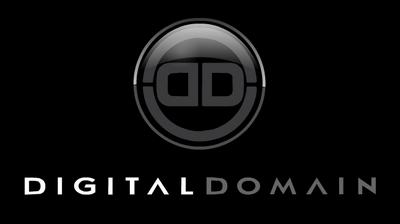June 2007 Archives
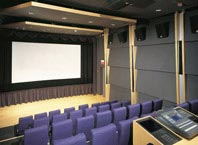 Boy.. Am I disappointed. It's been more than a week since I've placed an entry here, and I have no excuse. However, I thought I'd start off again with a rant. Today I attended the ATAS Visual Effects Nomination Voting, where we whittle down the entries to the top five which will ultimately be represented in the fall at this years 59th Annual Emmy Awards. This was held at Dolby Laboratories, just like last year, in Burbank.
Boy.. Am I disappointed. It's been more than a week since I've placed an entry here, and I have no excuse. However, I thought I'd start off again with a rant. Today I attended the ATAS Visual Effects Nomination Voting, where we whittle down the entries to the top five which will ultimately be represented in the fall at this years 59th Annual Emmy Awards. This was held at Dolby Laboratories, just like last year, in Burbank.
<rant> The reason I'm disappointed is two fold. Again, we had less than 30 people show up to vote (seems like a regular occurrence though), but more importantly, most of the quality of the work was really quite bad. Maybe I'm getting spoiled while working with film, but I know that comps can get very good on the TV side! The majority of what I voted on was pretty bad on the comp end, save for a few outstanding entries that deserve to be nominated. I really don't understand the mentality of submitting something that you know is broken to be voted on as a contender? It's just like making a demo reel.. Put your best work first and foremost. There are things we do to pay the bills, and those things aren't necessarily the ones we but on our reels! Simple things, like make sure the green edges aren't green when removing a greenscreen, don't have crunchy edges on key pulls, having skin become purple after pulling a key, making sure fire and explosions light up their environment, having interactive lighting on the inside of vehicles, simple things like these. I was just shaking my head in the theatre at some of these obvious mistakes, which comes down to; no time and less money. It sucks that the powers that be mandate that whatever they need has to get done in less than two weeks, in HD no less, and for less than what you did two months ago.. My goodness. The other disappointing thing is that all the footage was either on Digibeta or DVD. I think it's imperative to show the work as it was worked on, be it HD or SD. All the wonderful details and nuances that artists put in at HD resolution are lost when you downsize to DVD and DBeta. As well, the conversion to such a lower quality medium blurs all the errors, making many things look soft on a 30 foot wide theatre screen. </rant>
Argh. And how is everyone else's weekend coming along?
Every once in a while you encounter a bit of news that's just a little humorous. Here's an article in the Chicago Tribune documenting the work that Digital Domain did on We Own The Night, a mafia film. The best part? The Houdini. Here's a review of the film from Cannes.
The last day of the festival! This was by far one of the more star studded days, if you consider VFX luminaries like Richard Edlund and Doug Trumbull and others, stars! But we'll get into that shortly. Our first panel is with a familiar ogre.
10:00-11:30 Shrek through the Ages
 Ah, the green ogre is back! This panel showcased how Shrek and his cohorts have managed to become higher res and more complicated over the years. While not as dramatic a leap from Shrek 1 to Shrek 2, Shred the Third has some very subtle additions, that one wouldn't know unless you attended this panel! Most of the improvements were in the crowd duplications and setups for crowd characters. They had the ability to take several man and woman bodies, and adjust the proportions much easier than in the first two films. There was a huge improvement in environments from Shrek to Shrek 2, which is definitely apparent when you put the two films back to back! As well, Shrek the Third contained some great visuals of their cloth simulations. They were able to rig tight clothes with controls to allow the animators to keyframe them, as well allow for simulations of dresses and hair, to name a few. The panel consisted of Philippe Gluckman, VFX supervisor for the film, Guillaume Aretos, art director and designer, Tim Cheung, animation supervisor, and Lucia Modesto, character TD supervisor.
Ah, the green ogre is back! This panel showcased how Shrek and his cohorts have managed to become higher res and more complicated over the years. While not as dramatic a leap from Shrek 1 to Shrek 2, Shred the Third has some very subtle additions, that one wouldn't know unless you attended this panel! Most of the improvements were in the crowd duplications and setups for crowd characters. They had the ability to take several man and woman bodies, and adjust the proportions much easier than in the first two films. There was a huge improvement in environments from Shrek to Shrek 2, which is definitely apparent when you put the two films back to back! As well, Shrek the Third contained some great visuals of their cloth simulations. They were able to rig tight clothes with controls to allow the animators to keyframe them, as well allow for simulations of dresses and hair, to name a few. The panel consisted of Philippe Gluckman, VFX supervisor for the film, Guillaume Aretos, art director and designer, Tim Cheung, animation supervisor, and Lucia Modesto, character TD supervisor.
1:00-2:30 Pirates with John Knoll
John Knoll was the only one on this panel, which consisted of him describing some of the complex situations that have happened over the past three Pirates films. Originally, he was slated to just jump on this film between his bigger projects, but in ended up taking him all the way to the end of the trilogy! He described the various challenges the team had to meet, from ships and environments, to character animation and effects. In the first film it was mostly ships and environments, with the skeleton crew as well. There were numerous shots of miniature elements, most familiar the governors mansion (which only existed as miniature save for a very small facade) and the Black Pearl. One of the popular sequences was the skeleton fight near the end of the movie. All the skeleton sequences in this film required the actors to pantomime their performances. Once with their adversaries, and then again with nothing. The skeletons were added after in post, and surprisingly, it worked wonders. Unfortunately it made for a very tough time on set, since the actors had nothing to gauge their own actions against! This changed in the future films.
 In Pirates 2, we see Davy Jones, as well as improved miniature sets and environments. And lots and lots of roto! The entire sequence on Cannibal island was an amazing feat of rotoscoping, and those guys don't get as much credit as they deserve. Kudos! Again, the Black Pearl and similar ships were miniatures, with several partial full size sets for on deck scenes. There is a lot of information about Davy Jones, so I won't get into him, but I will delve briefly into the Imocap system that they used, which you I posted about yesterday. This matchimation system involved getting trackable data from the main camera while shooting, and this allowed the actors to perform with Davy Jones' crew. This made it much easier for the actors. Knoll said that usually there are two witness cameras in addition to the main camera while shooting, in case they need to fill in pieces behind other actors. Overall a great technology, and I have a feeling this will become much more prevalent in the future for CG actor integration.
In Pirates 2, we see Davy Jones, as well as improved miniature sets and environments. And lots and lots of roto! The entire sequence on Cannibal island was an amazing feat of rotoscoping, and those guys don't get as much credit as they deserve. Kudos! Again, the Black Pearl and similar ships were miniatures, with several partial full size sets for on deck scenes. There is a lot of information about Davy Jones, so I won't get into him, but I will delve briefly into the Imocap system that they used, which you I posted about yesterday. This matchimation system involved getting trackable data from the main camera while shooting, and this allowed the actors to perform with Davy Jones' crew. This made it much easier for the actors. Knoll said that usually there are two witness cameras in addition to the main camera while shooting, in case they need to fill in pieces behind other actors. Overall a great technology, and I have a feeling this will become much more prevalent in the future for CG actor integration.
 Pirates 3 boasts even more goodies. From even more ships and miniatures, to the maelstrom sequence, there was a plethora of goodness. Knoll showed footage from the sets in Palmdale for the sequences, and the lighting rig which was used, as well as the bluescreen setup. It was very elaborate! This panel only consisted of ILMs work on the three films, as there were several other houses that worked on it but have not discussed their work in the film. Knoll mentioned that previously on Pirates 2 they were able to achieve a high level of realism for Davy Jones, and as such, were able to hand off his character to some of the more junior lighters, while the seniors tackled a huge task, the Maelstrom. Because of the volume of data that had to be rendered, the team came up with an innovative way to get the detail in such a huge volume of space without killing the farm. Because you're only seeing a portion of the maelstrom, specifically the surface, they were able to do away with a huge volume to calculate, and instead, flatten the volume of the maelstrom and use adjustable gravitation forces. Once that was complete, they were able to stretch it back out to the correct size. Innovative and very cool.
Pirates 3 boasts even more goodies. From even more ships and miniatures, to the maelstrom sequence, there was a plethora of goodness. Knoll showed footage from the sets in Palmdale for the sequences, and the lighting rig which was used, as well as the bluescreen setup. It was very elaborate! This panel only consisted of ILMs work on the three films, as there were several other houses that worked on it but have not discussed their work in the film. Knoll mentioned that previously on Pirates 2 they were able to achieve a high level of realism for Davy Jones, and as such, were able to hand off his character to some of the more junior lighters, while the seniors tackled a huge task, the Maelstrom. Because of the volume of data that had to be rendered, the team came up with an innovative way to get the detail in such a huge volume of space without killing the farm. Because you're only seeing a portion of the maelstrom, specifically the surface, they were able to do away with a huge volume to calculate, and instead, flatten the volume of the maelstrom and use adjustable gravitation forces. Once that was complete, they were able to stretch it back out to the correct size. Innovative and very cool.
3:30-5:30 VES 50 Most Influencial VFX Films
Moderated by John Knoll


![]()
![]()
![]()
![]() This amazing panel was the reason to come to this years VES Festival. It was a roundtable discussion of the Top 50 Influencial visual effects films. While a few of the panelists did not know the final 50, each of them mentioned that the most influencial films are different from person to person. The panelists were John Dykstra, Richard Edlund, John Knoll, Dennis Muren, Ken Ralston, and Doug Trumbull. In an interesting set of events, John Knoll had an issue of Cinefantastique from back in the day, of which several panel members had interviews in, which Knoll had signed, as it was his inspiration to get into this business. The panel started with the discussion of Star Wars, and why it was so influencial.. It eventually boiled down to the five of them (excluding Knoll for a little period) talking about the good old days of what it was like on set, and what they had to do to accomplish a certain effect. It was extremely eye opening, and definitely worth attending. After a brief period they began to discuss how they started in the industry, and talked about the past. It was so good that soon, John Knoll received a message from the crew that there were only 15 minutes left of the panel! He jokely mentioned that they needed to get through the other 46 films! A great two hours, and I could listen to these guys talk to each other for an entire day.
This amazing panel was the reason to come to this years VES Festival. It was a roundtable discussion of the Top 50 Influencial visual effects films. While a few of the panelists did not know the final 50, each of them mentioned that the most influencial films are different from person to person. The panelists were John Dykstra, Richard Edlund, John Knoll, Dennis Muren, Ken Ralston, and Doug Trumbull. In an interesting set of events, John Knoll had an issue of Cinefantastique from back in the day, of which several panel members had interviews in, which Knoll had signed, as it was his inspiration to get into this business. The panel started with the discussion of Star Wars, and why it was so influencial.. It eventually boiled down to the five of them (excluding Knoll for a little period) talking about the good old days of what it was like on set, and what they had to do to accomplish a certain effect. It was extremely eye opening, and definitely worth attending. After a brief period they began to discuss how they started in the industry, and talked about the past. It was so good that soon, John Knoll received a message from the crew that there were only 15 minutes left of the panel! He jokely mentioned that they needed to get through the other 46 films! A great two hours, and I could listen to these guys talk to each other for an entire day.
6:30-9:30 2001:A Space Odyssey Screening, with Doug Trumbull
Doug started off this panel by showing us some never been seen production photographs from the creation of 2001, from massive 65mm cameras to 35mm projection cameras for the color readouts in the space station, as well as the centrifuge, and the camera tricks they used to accomplish such monumental tasks. It was unfortunate that he was rushed for time, as they had to start 2001 on a 35mm print, or else we'd run out of time!
Overall this VES weekend was a blast, and I saw some familiar faces, and met new ones! If you get a chance, attend next years, as I'm sure it'll be just as good. The VES Festivals are getting bigger and better as time goes on.
I'm going to go into this more tomorrow with the VES Pirates presentation with John Knoll, but I wanted to just add some of my own thoughts with where this technology is going, and how you can prepare for the inevitable onslaught of onset motion capture. If any of you ILM artists have experience with compositing or prepping these types of shots, feel free to comment, as I'm eager to hear your thoughts on my thoughts!
 It seems that this sort of motion capture is going to become more prevalent in the future, as it makes it easier to match an actors performance, and provides valuable feedback for all involved. Because of the ease of adding it to the set experience, I have a feeling that it's going to get more elaborate, and the cleanup for such live action plates will definitely be in higher demand. I don't know how much of this will get outsourced to other countries, because there is a need to keep it in house to manage what pieces of the suits might need to be removed. Here's an article from AWN covering the Imocap system, and what you can get from it. Notice that for the most part the characters cover up the suits, but what may happen in the future will allow for more elaborate shots which involve seeing through actors.
It seems that this sort of motion capture is going to become more prevalent in the future, as it makes it easier to match an actors performance, and provides valuable feedback for all involved. Because of the ease of adding it to the set experience, I have a feeling that it's going to get more elaborate, and the cleanup for such live action plates will definitely be in higher demand. I don't know how much of this will get outsourced to other countries, because there is a need to keep it in house to manage what pieces of the suits might need to be removed. Here's an article from AWN covering the Imocap system, and what you can get from it. Notice that for the most part the characters cover up the suits, but what may happen in the future will allow for more elaborate shots which involve seeing through actors.
Well, another day, and part of last Saturdays extravaganza. In the following two panels which rounded out night, we got a chance to hear about some of the moral and ethical problems with visual effects, as well as hear about some films which are just horrible, but also ones that are just so cult, that they're yours to enjoy.. Read on!
6:00-7:00pm VFX Manipulation: With Great Power comes Great Responsibility
Moderated by Van Ling
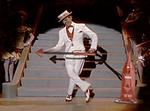 This panel was one of the better panels this evening, covering the moral and ethical aspects of visual effects, from commercial product placement and deplacement, to digital augmentation of characters for financial gain or art. There was some excellent commmentary by Ron Brinkman, John Knoll, Ray McIntyre and Patrick Davenport. Ron delved into the history of photo manipulation, which isn't new, and segued into the manipulation of video.
This panel was one of the better panels this evening, covering the moral and ethical aspects of visual effects, from commercial product placement and deplacement, to digital augmentation of characters for financial gain or art. There was some excellent commmentary by Ron Brinkman, John Knoll, Ray McIntyre and Patrick Davenport. Ron delved into the history of photo manipulation, which isn't new, and segued into the manipulation of video. In it, there were a significant showcase of commercials, from Gene Kelly and Dirt Devil, Cary Grant and VW, and Steve McQueen and Ford. Of course, their estate bought off on the rights to use these people in their films, but is this an ethical question if everyone is happy? Some may say that we, as viewers, are disgusted that the family of Steve would bow down to financial pressure to put him posthumously into a Ford commercial. What do you think? Where do you cross the line with augmenting reality for personal or political or financial gain? We've seen it time and time again. One of the members of the audience asked of John Knoll about the rerelease of Star Wars, why? why do it? Knoll responded that he was the best qualified to do the job, and he was following orders, pretty much.. If he didn't do it, someone else would that was less qualified, and it would have been a worse job. There's always that, and I agree with it.
8:30-10:00pm VFX Guilty Pleasures
Moderated by Gene Kozicki
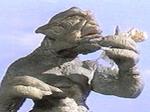 This exciting panel was much shorter than I anticipated! Most of the really interesting panels ended before one could get really into it.. This was a roundtable discussion of some of the guilty pleasures of visual effects. Bad, bad, bad movies that everyone hates but you. Films like Eight Legged Freaks, Flash Gordon, Flesh Gordon, Land of the Lost, Pirahna, and so forth. It was an interesting panel, even if I I haven't heard of any of these films, and there's a reason that most of these films faded into obscurity. Gene mentioned that before the days of late night infomercials, they would show these second rate movies, with classic effects, and this was how you'd be able to get introduced to these films.. Unfortunately, nowadays you have to actively seek out these films or get recommended them by a friend, which makes it much harder to apppreciate some of the finer effects done in these horrendous films.
This exciting panel was much shorter than I anticipated! Most of the really interesting panels ended before one could get really into it.. This was a roundtable discussion of some of the guilty pleasures of visual effects. Bad, bad, bad movies that everyone hates but you. Films like Eight Legged Freaks, Flash Gordon, Flesh Gordon, Land of the Lost, Pirahna, and so forth. It was an interesting panel, even if I I haven't heard of any of these films, and there's a reason that most of these films faded into obscurity. Gene mentioned that before the days of late night infomercials, they would show these second rate movies, with classic effects, and this was how you'd be able to get introduced to these films.. Unfortunately, nowadays you have to actively seek out these films or get recommended them by a friend, which makes it much harder to apppreciate some of the finer effects done in these horrendous films.
Overall, this was an excellent day.. Very long, but very interesting! It was also one of the first days that I braved the LA traffic on a bus! The venue they were holding this years VES Festival was at the Writers Guild Theatre, with almost no parking in the area.. On Friday I mistakenly parked in the festival lot, and it was 14 dollars! On Saturday I took the bus, and it cost me 2 bucks round trip, and it took about the same amount of time. It's not too bad if you know where you want to go!
Day 2 of the VES Festival started off with a bang! This was an exciting day, and only to be improved upon when this show wraps up on Sunday! Without further ado, the topics and my thoughts and summaries.
10:00-11:30 Spiderman3
 This panel hosted Jonathan Cohen, Spencer Cook, Peter Nofz, and Scott Stokdyk, vfx supervisor for Spiderman3.
This panel hosted Jonathan Cohen, Spencer Cook, Peter Nofz, and Scott Stokdyk, vfx supervisor for Spiderman3.
I haven't seen the film, but after seeing some of the visual effects, I think it's only fair that I head to the theatre to catch this one in 2k glory before it's relegated to the annals of the DVD shelves.
This panel went over the creation of the Venom black goo and Sandman's birth and sand. Clips from the film were shown, as well as breakdowns on the birth of Sandman sequence, and a couple of other sequences..Sphere simulation, where grains of sand as spheres, where simulated to give the illusion of millions of sand particles. During the beginning of the sequence, a couple sand grains were keyframed, which then fell into a simulation of multiple sand grains. The actor was matchmoved and his motion was conveyed through surface sand simulation, with slow blending into the real actor as he walks forward. There was some fluid sim for sand.
For venoms goo, there were lots of keyframe animation for good strands, with procedural goo between the main goo strands. Originally they wanted to have a fully procedural approach, but there would be no direction that way, so keyframed animation was the way to go, with procedural goo for the smaller and filler bits. They showed a bunch of Venom goo shot breakdowns, with the big kicker in the church, when Topher Grace gets attacked and it overcomes him.
The CG environments were much simpler for this film. Not much had changed from the second film, but the buildings got a little more elaborate, and there was some miniature work in the film.
1:00-2:30 The Art of the Miniature
Moderated by Ian Hunter
This panel consisted of Scott Schneider, Aaron Haye and Matthew Gratzner. They went over four films that each of the worked on where the turnaround time for miniature creation and shooting was less than 3 weeks. These films were Don't Say A Word, Constantine, Star Trek Insurrection, and The Forgotten. Most of the miniature shots described were done in 2 to 3 weeks, from planning to final photography. A couple shots, like in Insurrection and Constantine, relied on CNC millingin machines to accurately create miniature pieces from either onset plans or 3D models. Most of the below shots were shot at high speed.
In the film, Don't Say A Word, Sean Bean's demise near the end of the film was accomplished with several miniature shoots. They had several miniature sets, a half, a full, and a third sized set. The set comprised a trench, lined with earth on either side, which exploded inward and covered the trench with earth. The full sized set was partially built, to accomodate the effects of Sean Bean getting covered in dirt. They did several takes, which were then composited together with footage of Sean running on a greenscreen. There was another shot in the show where they did an element shoot to put parade floats into the reflection of Michael Douglas' car.
In Constantine, Rachel Weisz gets pulled into the air through a building by the angel Gabriel. One of the sets, which was shot in the trailer, was a small cubicle room which ripped apart as she was pulled through it. Aaron Haye supervised and built the set, which consisted of miniature office supplies and walls and the like. The set could be pulled apart down the middle to ease the task of resetting each shoot. The set was rigged with lines and pneumatic rams and a doll of Rachel was positioned in the center of the action. The breakdowns for this scene were very cool, and it does show how much effort is done to give you a very short shot in the film!
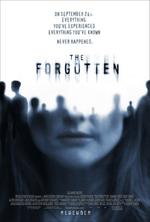 In The Forgotten starring Julianne Moore, several sequences in the film used miniature effects. In the one they showcased for this event, the roof of an armory gets ripped off near the end of the film. They build two armory sets, which they proceeded to film and demolish from the outside in. They couldn't use air rams from inside the building, as the magical alien force is supposed to be outside. An external rig with a plethora of wires attached to the outside of the armory yanked the building apart. They shot these takes vertically, so they would be able to whip pan up in the comp.
In The Forgotten starring Julianne Moore, several sequences in the film used miniature effects. In the one they showcased for this event, the roof of an armory gets ripped off near the end of the film. They build two armory sets, which they proceeded to film and demolish from the outside in. They couldn't use air rams from inside the building, as the magical alien force is supposed to be outside. An external rig with a plethora of wires attached to the outside of the armory yanked the building apart. They shot these takes vertically, so they would be able to whip pan up in the comp.
In the last film, Insurrection, the building of the Collector ship at the end of the film was a miniature, as it blew up. The other shots in the film of it are a CG model. They did a wipe from the CG to the miniature as it blows up. The scale was achieved correctly since they already had the 3D model, they could cut pieces on a CNC machine. This worked out really well, and they exploded the ship on the first take the way they wanted to. This was similar to a shot I did in The Matrix, when the Hammer crashes into the pilons in the Zion dock. It was a CG model, but it didn't wipe to the miniature model. Instead, I used the flames and explosions from the miniature ship and placed them into the 3D ship.
I'd also like to add some trivia that Ian Hunter and Matthew Gratzner had their last names featured in Pitch Black. It was the name of the ship that crashs on the planet. The ship was called the Hunter-Gratzner. Be sure to check out their great work over at New Deal Studios!
3:30-5:00 Previz: All the Ins and Outs
Moderated by Tad Leckman
This panel featured a collection of artists from a number of different companies, The Third Room, The Ranch, Pixel Liberation Front, and Proof. Tad is a SCAD teacher, originally from ILM, and described different techniques of previs and what it encompassed, from animatics to videomatics to story reels and 3D animatics. There was a wealth of information, and previs is starting to gain steam with directors to get their vision into visual form before they even start shooting. They are responsible for camera interaction on set, and it has been occasionally required for the previs department to provide the production with details on sizes and purchase requirements for equipment to be used. They gave the number of gallons of chocolate for Charlie and the Chocolate Factory and the amount of turf needed. The panelists were; Colin Green, Mat Beck, Ron Frankel, Tad Leckman, and Matthew Ward.
Coming tomorrow, VFX Manipulation: With great power comes great responsibility and VFX Guilty Pleasures! Be sure to get the RSS feed or subscribe via email on the right hand side of this page! All this week, summaries and thoughts from last weekends VES Festival.
This weekend is the VES Festival, held this year at the Writers Guild Theatre in Beverly Hills. I took some time out to take in all the presentations, and over the next couple of days I'll be going over what they were about! The Friday session was very good, as I'll describe below!
2:30-4:00: Rendering Cinematic Game Experiences in Real Time
 Moderated by Van Ling
Moderated by Van Ling
This hour and a half long panel delved into the work necessary to create two of Activisions games, Call of Duty 3, and Spiderman 3, both for the XBox360 and Playstation 3. Steve Pierce, CTO of Activision, explained some of the differences between this generation and the previous generation of console hardware, and how they differ. From parallel CPU processing, to a GPU 51 times faster than the previous generation, all rendering images at double or triple the resolution in 720p at 60 frames a second. They also mentioned that they're not limited by the space on the discs anymore, but mostly by the transfer rate from the discs to the machines themselves.
5:00-6:30: VFX FOR SPECIAL VENUES
 Moderated by Jeff Kleiser
Moderated by Jeff Kleiser
This panel, consisting of David Smith of Busch Entertainment, Doug Trumbull, Rob Engle of SPI, and Jim Bowie of Electrosonic, went into extensive detail about the creation of visual effects for special venues. First up was David, who's introduction and talk wasn't the most informative about visual effects perse, and seemed more of a corporate speech given to entice the audience into understanding what Busch Entertainment brings to the world. I did find out that Busch owns and operates nine parks in the states, including Seaworld and of course, Busch Gardens.
Trumbull talked about his intensive work in special venues, specifically the Back to the Future Ride which will be closing its doors at the end of the summer! He talked about the immersive quality of ride films, and how he accomplished the ride using miniatures, and the logistics of creating a ride film in dome IMAX, when only a certain amount of light was able to hit the screen otherwise you'd get cross reflectance, from light bouncing off one side of the screen and hitting the other.
Engle talked briefly about his role in 3D stereoscopic films, mostly about how they created a full 3D version of films from their 2D counterparts, in roughly a quarter the time! I can relate! The stereo conversion for Meet The Robinsons was very short.
Jim Bowie talked about the types of immersive environments prevalent in special venues, and showed examples of his work and others in the special venue field that his company has helped design. From large format regular screens, to IMAX dome projections, and hologram displays like Chioptics Pepper's Ghost illusion, which consisted of a display technology of an inverted pyramid capable of displaying holograms.
7:30-10:00: SURF’S UP Screening (Sony Pictures Imageworks) with Q&A
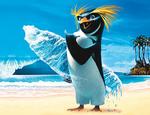 The last panel of the evening consisted of a screening of Surf's Up, from Imageworks Animation, followed by a quick Q/A from the supervisors. Most of the technical discussion will be held at Siggraph, but they did discuss some aspects of the film. If you haven't seen it yet, I highly recommend it.. Much better than the other penguin movie. The water in the film took approximately 2 and a half years to achieve. The film is also shot in a documentary style with handheld cameras, so the layout department used a rig to film the animation in realtime to give the illusion of a handheld, documentary, camera. This film did have film grain added, which adds to the illusion of a documentary film.
The last panel of the evening consisted of a screening of Surf's Up, from Imageworks Animation, followed by a quick Q/A from the supervisors. Most of the technical discussion will be held at Siggraph, but they did discuss some aspects of the film. If you haven't seen it yet, I highly recommend it.. Much better than the other penguin movie. The water in the film took approximately 2 and a half years to achieve. The film is also shot in a documentary style with handheld cameras, so the layout department used a rig to film the animation in realtime to give the illusion of a handheld, documentary, camera. This film did have film grain added, which adds to the illusion of a documentary film.
Over the next two days I'll be summing up my thoughts and what else happened at this years VES Festival of Visual Effects! The Saturday and Sunday panels were amazing, and I hope you all had a chance to see it. If not, next year should be just as great!
More goodies from the Academy of Television Arts and Sciences! Below are just a couple of the bigger, more extravagant DVD packages.
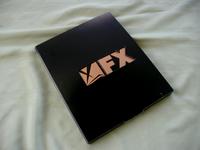
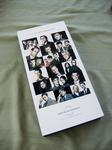
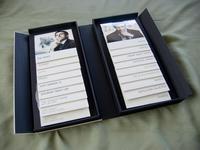
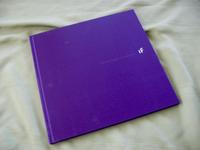
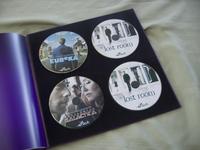
There were a couple stray DVDs in single slipcases, like Ghost Hunters, COPS, Henry Rollins: Uncut from Israel, TVLand 2007 Awards, AMC Originals, and My Name is Earl, to name a few. There are tons in a pile in my living room, and there's no way I'll be able to watch them all. Luckily I won't have to, as we'll be narrowing down this batch into more manageable ones in August. This year I hope to again vote my Peer Category: Title Design and Special Visual Effects. Read these entries to see how it was last year!
